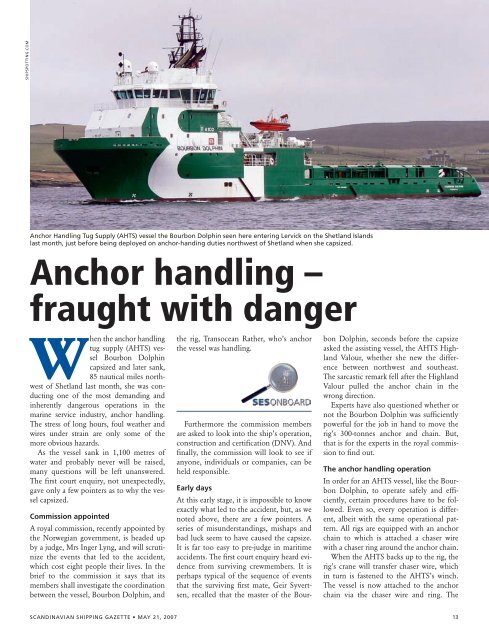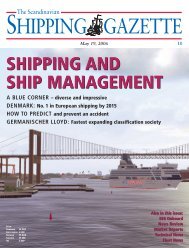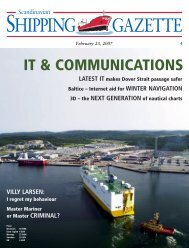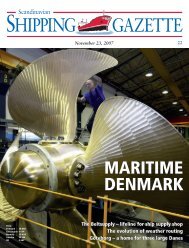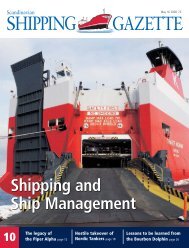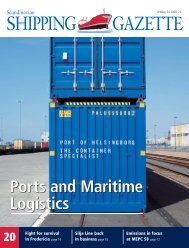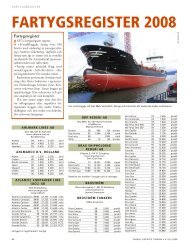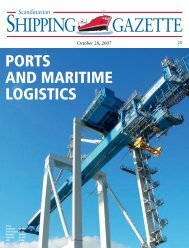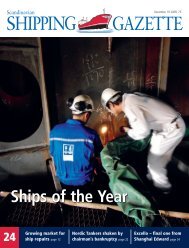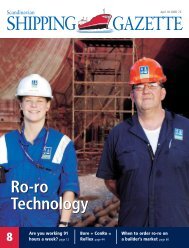SSG No 10 - Shipgaz
SSG No 10 - Shipgaz
SSG No 10 - Shipgaz
You also want an ePaper? Increase the reach of your titles
YUMPU automatically turns print PDFs into web optimized ePapers that Google loves.
SHIPSPOTTING.COM<br />
Anchor Handling Tug Supply (AHTS) vessel the Bourbon Dolphin seen here entering Lervick on the Shetland Islands<br />
last month, just before being deployed on anchor-handing duties northwest of Shetland when she capsized.<br />
Anchor handling –<br />
fraught with danger<br />
When the anchor handling<br />
tug supply (AHTS) vessel<br />
Bourbon Dolphin<br />
capsized and later sank,<br />
85 nautical miles northwest<br />
of Shetland last month, she was conducting<br />
one of the most demanding and<br />
inherently dangerous operations in the<br />
marine service industry, anchor handling.<br />
The stress of long hours, foul weather and<br />
wires under strain are only some of the<br />
more obvious hazards.<br />
As the vessel sank in 1,<strong>10</strong>0 metres of<br />
water and probably never will be raised,<br />
many questions will be left unanswered.<br />
The first court enquiry, not unexpectedly,<br />
gave only a few pointers as to why the vessel<br />
capsized.<br />
Commission appointed<br />
A royal commission, recently appointed by<br />
the <strong>No</strong>rwegian government, is headed up<br />
by a judge, Mrs Inger Lyng, and will scrutinize<br />
the events that led to the accident,<br />
which cost eight people their lives. In the<br />
brief to the commission it says that its<br />
members shall investigate the coordination<br />
between the vessel, Bourbon Dolphin, and<br />
the rig, Transocean Rather, who’s anchor<br />
the vessel was handling.<br />
Furthermore the commission members<br />
are asked to look into the ship’s operation,<br />
construction and certification (DNV). And<br />
finally, the commission will look to see if<br />
anyone, individuals or companies, can be<br />
held responsible.<br />
Early days<br />
At this early stage, it is impossible to know<br />
exactly what led to the accident, but, as we<br />
noted above, there are a few pointers. A<br />
series of misunderstandings, mishaps and<br />
bad luck seem to have caused the capsize.<br />
It is far too easy to pre-judge in maritime<br />
accidents. The first court enquiry heard evidence<br />
from surviving crewmembers. It is<br />
perhaps typical of the sequence of events<br />
that the surviving first mate, Geir Syvertsen,<br />
recalled that the master of the Bour-<br />
bon Dolphin, seconds before the capsize<br />
asked the assisting vessel, the AHTS Highland<br />
Valour, whether she new the difference<br />
between northwest and southeast.<br />
The sarcastic remark fell after the Highland<br />
Valour pulled the anchor chain in the<br />
wrong direction.<br />
Experts have also questioned whether or<br />
not the Bourbon Dolphin was sufficiently<br />
powerful for the job in hand to move the<br />
rig’s 300-tonnes anchor and chain. But,<br />
that is for the experts in the royal commission<br />
to find out.<br />
The anchor handling operation<br />
In order for an AHTS vessel, like the Bourbon<br />
Dolphin, to operate safely and efficiently,<br />
certain procedures have to be followed.<br />
Even so, every operation is different,<br />
albeit with the same operational pattern.<br />
All rigs are equipped with an anchor<br />
chain to which is attached a chaser wire<br />
with a chaser ring around the anchor chain.<br />
When the AHTS backs up to the rig, the<br />
rig’s crane will transfer chaser wire, which<br />
in turn is fastened to the AHTS’s winch.<br />
The vessel is now attached to the anchor<br />
chain via the chaser wire and ring. The<br />
SCANDINAVIAN SHIPPING GAZETTE • MAY 21, 2007 13


